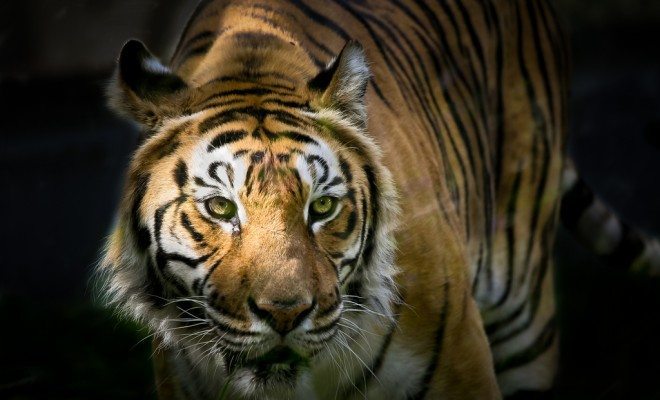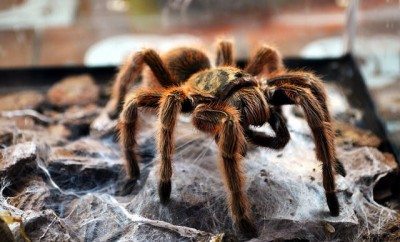 Image courtesy of [Patrick Bouquet via Flickr]
Image courtesy of [Patrick Bouquet via Flickr]
Energy and Environment
Owning Exotic Pets is Dangerous and Unethical
Dogs may be our best friends, but some people take interest in far more unusual choices for pets. Whether it be driven by a desire for a display of status, a sense of adventure, or simply an interest in doing something different, keeping exotic pets presents a series of problems.
Exotic pets by definition come from a different ecosystem, and they pose the threat of carrying with them invasive species. An East Asian fungus threatens to wipe out American salamanders. This fungus arrives in part on Chinese fire belly newts, which are particularly popular and are imported into the United States by the hundreds of thousands annually. Salamanders play an underappreciated and barely visible yet vital role in the environment. Keeping specific insect populations in check, they subsequently serve as food for certain rodents and small predators that in turn operate in important manners. Each animal is an important link in a chain, the removal of which could induce a fracturing of the delicate structure.
Snakes are another common type of exotic pet, relatively popular in Florida. It is unfortunate how frequently one hears a story on the news about a pet snake escaping. Something like a python is huge and powerful, and can turn on its owner or on people whom it may come across as it flees. Small children and other pets, like small dogs, are susceptible. I know someone whose friend had a pet python that escaped. She said that one day they flipped open the toilet lid and found it in there. This must surely have been quite a shock, and is a very unsettling place to find a dangerous wild animal! Furthermore, because snakes of this kind are predatory and already at the top of the food chain, introducing them into an environment of which they were not previously a part can be just as damaging as the salamander situation. In this case, though, the snake itself is the invasive species, multiplying out of control as there is nothing to keep it in check, while feeding unchallenged on the prey of its choice, potentially endangering the populations of those animals.

Courtesy of Katy Warner via Flickr.
The reason that animals like pythons have a tendency to escape and are quite capable of subsequently surviving is that they are wild. Ancient humans were only able to domesticate fourteen species of large herbivorous animals: sheep, goats, cows, pigs, horses, Arabian (one humped) camels, Bactrian (two humped) camels, llamas, donkeys, reindeer, water buffalo, yaks, Bali cattle, and the mithan, which is also something of a relative to cattle. The primary means by which humans did this was to tap into their social structure. Horses, for example, live hierarchically. Therefore a human must replace the alpha male at the top of the pyramid and the rest of the group will follow. It is worth noting that wolves also have a hierarchical social structure. Thus one will notice that dogs are more naturally submissive to humans than cats, whose relatives and ancestors do not adhere to these same patterns.
It is more complicated than that, though. Some relatives of domesticated animals cannot be domesticated for other reasons. For example, zebras simply cannot be saddled, ridden, and trained the way horses can. Although they have the same hierarchal social structure as horses, other factors including diet, complications over captive breeding, or genetic traits tied into disposition or a propensity to panic will render an animal non-domesticable. Any individual trait, much less a combination of them, will yield this result, making an animal unsuitable to be a pet.
Ethical questions also present themselves with regard to keeping wild animals as pets. Aside from farm foul, no other type of bird is domesticable. Yet these are not uncommon sights in people’s homes. Having the ability to fly, birds possess a supreme gift of nature, one that mankind himself has dreamed about and aspired to throughout his existence. Nonetheless we selfishly deprive pet birds of it so that we can look at them while they sit perched in a small cage, denying them the ability to do what they are built to do.

Courtesy of elwarren via Flickr.
On a similar note, no types of predators should serve as pets either. In a somewhat Hollywood-esque conceptualization, we think of keeping something like a tiger as a pet as a demonstration of machismo and power. High-ranking antagonists in movies threaten to throw their adversaries to their vicious tigers like slabs of meat. But just the same as birds and their desire to fly, an apex predator is driven by its genes to hunt. We can poetically describe the action of handing a hunter its food instead of letting it pursue the hunt itself as killing its soul, but in a sense this is what is occurring. Whatever concepts of status we might procure are not worth the price of the damage consequently inflicted on such an animal. In addition, animals like this hold an appeal because of their wildness. If we take that away we negate its very mystique.
Once again we are attempting to tame aspects of nature that are beyond our control, with damaging consequences. We do not need to imprison wild animals in our homes in order to appreciate them. It would be much more productive to environmental consciousness to instead journey out into the wilderness ourselves and see them in their own element, where they belong.






Comments